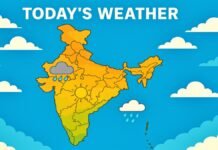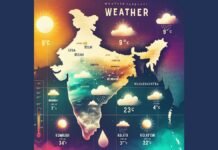
Key Points
- IMD forecasts above-normal monsoon rainfall for India in 2025, with expected rainfall at 106% of the Long Period Average (LPA).
- June 2025 may see even higher rainfall—up to 108% of LPA, exceeding 87 cm across the country.
- Central and South India, including Madhya Pradesh, Chhattisgarh, Maharashtra, and Odisha, are likely to receive surplus rainfall.
- Some states Punjab, Haryana, Kerala, Tamil Nadu, Bihar, and Jharkhand may see below-normal rainfall.
- The monsoon is crucial for agriculture in the core monsoon zone, which relies heavily on seasonal rains.
New Delhi: India is set for a wetter-than-usual monsoon season in 2025, with the India Meteorological Department (IMD) projecting rainfall at 106% of the Long Period Average (LPA) for the June-September period. This is a slight upward revision from last month’s forecast of 105%. The IMD also predicts an exceptionally rainy June, with expected precipitation at 108% of LPA meaning more than 87 cm (870 mm) of rainfall nationwide.
Region-wise Rainfall Outlook
IMD Director General Mrityunjay Mahapatra announced that the core monsoon zone which includes Madhya Pradesh, Chhattisgarh, Maharashtra, Odisha, and surrounding regions will be the biggest beneficiary of this year’s monsoon surge. These areas are expected to receive well above normal rainfall, which is excellent news for farmers who rely on monsoon showers for crop irrigation.
However, not all regions will be equally fortunate. The IMD cautions that:
- Punjab, Haryana, Kerala, and Tamil Nadu are likely to receive below-normal rainfall.
- Bihar and Jharkhand may also experience a shortfall in monsoon rains.
- Northwest India is expected to receive normal rainfall.
- Northeast India could see less than normal rain.
What is Long Period Average (LPA)?
The Long Period Average (LPA) is the benchmark used by the IMD to assess monsoon performance. Calculated over the period 1971-2020, the LPA for the southwest monsoon stands at 87 cm (870 mm). Rainfall above this threshold signals an above-normal or surplus monsoon, while anything below indicates a weak monsoon.
Why This Forecast Matters
The core monsoon zone, comprising states like Madhya Pradesh, Chhattisgarh, Maharashtra, and Odisha, is heavily dependent on monsoon rainfall for agriculture. A surplus monsoon boosts crop yields, supports rural livelihoods, and positively impacts the national economy. However, regions expecting below-normal rainfall may need to prepare for potential water shortages and agricultural challenges.
Outlook for Farmers and Policymakers
With the IMD forecasting a robust monsoon, farmers in Central and South India can look forward to a promising kharif season. Policymakers and state governments in regions with expected rainfall deficits should plan for water conservation and contingency measures to mitigate possible drought-like conditions.
Monsoon 2025 is shaping up to be wetter than usual for most of India, especially in the central and southern states. While this bodes well for agriculture and water resources in these regions, vigilance is needed in states where rainfall may fall short. The IMD’s optimistic forecast brings hope for a strong agricultural year, but also a reminder to prepare for regional disparities in rainfall.













































